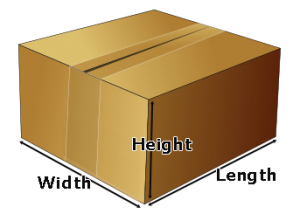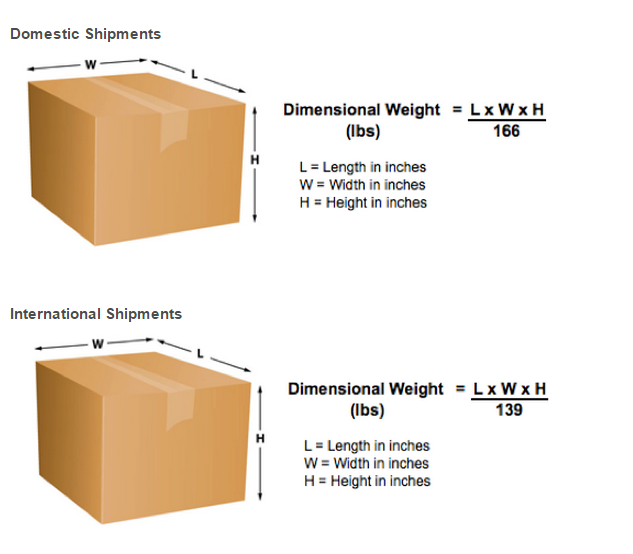
Dimensional Weight
Dimensional weight, used in shipping and freight, is an invoicing technique which takes into account the XYZ axis dimensions of a package.

Shipping costs have historically been calculated on the basis of gross weight in kilograms or pounds. By charging only by weight, lightweight, low density packages become unprofitable for freight carriers due to the amount of room they take up in the truck/aircraft/ship in proportion to their actual weight. The concept of Dimensional Weight has been assumed by the transportation industry nationally as a uniform means of instituting a minimum charge for the cubic space a package occupies.
Weight Calculation
Dimensional weight is a calculation of a theoretical weight of a parcel. This theoretical mass is the weight of the package at a minimum density chosen by the freight carrier. If the package is beneath this minimum density, then the actual weight is superfluous as the freight carrier will charge for the volume of the package as if it were of the chosen density (what the package would weigh at the minimum density). Furthermore, the volume utilized to figure the Dimensional Weight may not be completely representative of the accurate volume of the package. The freight carrier will calculate the longest dimension in each of the three axis (X,Y,Z) and use these measurements to establish the package volume. If the package is a right-angled rectangular cuboid (box), then this will be equal to the true volume of the package. However, if the package is of any other profile, then the calculation of volume will be more than the true capacity of the package.

Dimensional weight is also known as DIM Weight, volumetric weight, Cubed Weight, etc. Freight carriers utilize the greater of the actual weight or dimensional weight to calculate shipping fees. Dimensional Weight is calculated as (Length x Width x Height) / (Dimensional Factor). Measurements can be made all in inches or all in centimeters, but the appropriate shipping factor must also be used.
Shipping factors for imperial measurements denote cubic inches per pound (in3/lb) while metric factors represent cubic centimeters per kilogram (cm3/kg). These are the inverse of the package density. Dimensional Weight is applied when the actual product density is less than the minimum density represented by the chosen factor. Dimensional Weight is representative of the weight of the package at the minimum density established by the freight carrier. Shipping factors are not only different for imperial and metric measurements, but also for shipment mode. Shipping factors will be available from your freight carrier. Some frequent factors are listed below.
Imperial Shipping Factor examples:
- 166 in3/lb = 10.4 lb/ft3 - common for IATA shipments
- 194 in3/lb = 8.9 lb/ft3 - common for domestic shipments
- 216 in3/lb = 8.0 lb/ft3
- 225 in3/lb = 7.7 lb/ft3
- 250 in3/lb = 6.9 lb/ft3
Metric Shipping Factor examples:
- 5000 cm3/kg = 200 kg/m3
- 6000 cm3/kg = 166.667 kg/m3
- 7000 cm3/kg = 142.857 kg/m3
When calculating the dimensional weight with metric measurements, the Length, Width, and Height are measured in centimeters (cm) and the result is confirmed in a nominal kilogram (kg) dimensional weight band (usually rounded up).
Some Calculations for Major Courier/Shipping Companies are as follows:
- DHL: (L cm x W cm x H cm)/6000
- FedEx: (L cm x W cm x H cm)/6000 (new) or /5000 (old, still used in Asia) for international shipments, (L cm x W cm x H cm)/7000 for domestic shipments
- UPS: (L cm x W cm x H cm)/6000 or /5000 depending on certain import/country criteria• Canada Post (L cm x W cm x H cm)/6000 or (L in x W in x H in)/165
Practical Application
Dimensional weight favors shippers of dense objects and penalizes those who ship lightweight boxes. A box of un-popped corn kernels will probably be charged by gross weight; a box of popcorn will likely be charged by its dimensional weight. This is because the hefty box of popcorn takes up a lot of space but does not fill up a vehicle's capacity in terms of weight, making it an inefficient use of space.
Shippers evade dimensional weight charges by using smaller boxes, by compressing their goods, and by reducing the use of packing equipment.
Commercial Use
Dimensional weight is frequently used for billing by air freight forwarders, truck carriers, in addition to all commercial airlines worldwide. In 2007, DHL, FedEx, United Parcel Service and USPS adopted the dimensional weight system for ground services.
In May 2007, the United States Postal Service (USPS) adopted dimensional weight, calling it "Shape Based Postage Pricing". This rate method is intended to charge more for lightweight items and also to recover costs involving manual sorting and handling, since many postal machines are built to handle flats. This system would charge much more for mailing a parcel than a flat envelope. It encourages mailing books and DVDs in flat paperboard or plastic envelopes instead of padded mailers.

Such companies use programmed systems called dimensioners for calculating both dimensional and actual weight and invoice their customers accordingly. More and more transport and logistics companies, including warehouses and retailers, are investing in dimensioning equipment for calculating the dimensional weight of their parcels in order to keep in check with their carriers and evade additional back charges.
See also:








